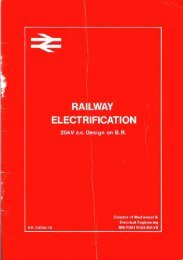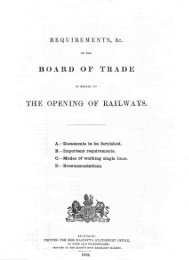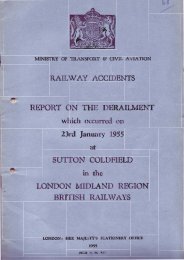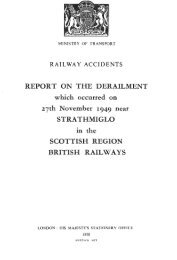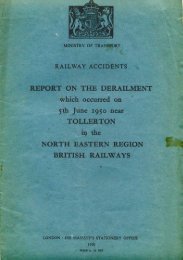R A I LT R AC K - The Railways Archive
R A I LT R AC K - The Railways Archive
R A I LT R AC K - The Railways Archive
You also want an ePaper? Increase the reach of your titles
YUMPU automatically turns print PDFs into web optimized ePapers that Google loves.
1<br />
146<br />
West Coast Main Line: London to Glasgow and Edinburgh continued<br />
<strong>The</strong>se are the route improvements we plan to deliver continued<br />
Rugby–Carlisle From Rugby to Colwich (75km), the four-track sections are interspersed with a three-track section from Rugby to Attleborough and a two-track<br />
section from Tamworth to Armitage which substantially reduces effective capacity. Crossing moves at Nuneaton, Lichfield and Colwich and stops by<br />
selected trains at Rugby, Nuneaton, Tamworth, Lichfield and Stafford further reduce capacity.<br />
<strong>The</strong> Colwich to Stafford section (9km) is partially a two-track section and is also constrained by slow line conflicts at Milford, Whitehouse and Trent<br />
Valley Junction at Stafford.<br />
From Stafford to Crewe (38km), the line is four track but effective capacity is reduced by crossing moves at Norton Bridge Junction to and from the<br />
Manchester Line and the fast and slow lines, and also at Basford Hall.<br />
At Crewe Station, various crossing moves which consume capacity cannot currently be avoided: freight trains into and out of Basford Hall yard; and<br />
trains to and from the Shrewsbury, Manchester and Chester lines have to cross many of the main lines.<br />
<strong>The</strong> C rewe to Carlisle section is two track for 85% of its 250km length. Capacity is highly used on the two-track sections between Winsfo rd and<br />
We aver Junction, and is further constrained by the mix of speed, the need for Liverpool–St Helens–Wigan trains to use the main line from Springs<br />
Branch to Wigan, the mixed traffic speeds on the Wigan–Balshaw Lane two-track section, the single lead junction with nu m e rous crossing moves at<br />
Euxton, and limited slow line platforming capacity at Preston. Again, diffe rential speeds of trains mean that many trains consume more than one<br />
‘ s t a n d a rd path’ from Preston to Carlisle. At Carlisle Station, there is limited capacity to handle freight trains.<br />
Option A Provide four miles of additional fourth track and five miles of additional third and fourth tracks between Rugby and Stafford.<br />
We will then be able to path the additional 42 freight and open access trains between Rugby and Crewe as set out in our PUG 2 undertaking<br />
with the Rail Regulator.<br />
Option B Provide four tracks throughout the Trent Valley to double capacity in this area which would require 9km of fourth track, 16km of third<br />
and fourth tracks, including creation of new track through National Trust Land, and widening of Shugborough Tunnel. This doubles the capacity in<br />
the Trent Valley, allowing an additional 14 trains per hour to be pathed between Rugby and Stafford.<br />
Option C Divert trains that exceed this route’s capacity via Coventry and Walsall. <strong>The</strong> Coventry–Walsall Corridor is currently operating at full<br />
capacity and the planned improvements to capacity (under PUG 2) will be fully utilised by contracted additional services. <strong>The</strong>re would be a need for<br />
heavy investment if trains were to be diverted this way from Trent Valley. Additional work would four-track the railway from Beechwood Tunnel to<br />
Stechford, provide a grade-separated junction at Stechford and need other off-WCML works.<br />
Option D Stafford–Crewe: reduce crossing moves at Norton Bridge and Crewe and thereby increase effective capacity.<br />
Grade-separated junction at Norton Bridge. Increased utilisation of independent lines and Basford Hall sidings at Crewe facilitated by improved yard<br />
arrival/departure facilities. NB: <strong>The</strong> junction layout at Crewe is proposed for improvement under PUG 2. Additionally, improved platform capacity<br />
could be provided here and, further improvements made to the layout. At Norton Bridge, a grade-separated junction would avoid approximately<br />
four crossing moves per hour and, at Basford Hall near Crewe, possible layout changes would create approximately two additional paths per hour<br />
for freight trains. However, unless works to alleviate congestion north and south of this area are undertaken, no advantage can be taken of such a<br />
capacity improvement.<br />
Option E Four track from Winsford to Weaver (eight miles). Two viaducts would also have to be widened as part of the eight-mile four tracking.<br />
Option F Avoid crossing fast lines at Euxton and encourage efficient use of slow lines between Euxton and Preston by Blackpool services. Provide<br />
grade-separation doubling of the junction at Euxton. Reallocate platforms at Preston.<br />
Option G Ease the capacity consumption caused by differential speeds over Shap summit through provision of a third track northbound between<br />
Carnforth and Shap summit, and southbound from Carlisle to Shap summit. Assuming each freight path consumes 2.5 nominal paths on the incline,<br />
all services aspired to could be accommodated.<br />
A is our preferred option as no viable potential funding package has been identified for additional capacity on this route which the other<br />
options will provide.<br />
Manchester network development We have analysed the current network capacity of all of our routes radiating from Manchester, together with our assessment of future market<br />
developments for both passenger and freight operations to determine an appropriate way forward. Our strategy is:<br />
(1) To invest in infrastructure between Manchester Piccadilly and Crewe, which will enable the new Virgin Trains’ West Coast services (committed<br />
to in the ‘PUG 2’ agreement) and other operators services using current track access rights to be delivered reliably.<br />
This objective assumes that the track access rights of franchise operators that expire in 2004 are renewed in similar form. We have already<br />
remodelled the track layout at Manchester Piccadilly and restored the capacity to 12 fully operational platforms in the main trainshed. About<br />
£100M will be spent on completely renewing the signalling between Slade Lane and Cheadle Hulme, and in providing altered track configuration<br />
to optimise train path capability.<br />
(2) To provide costed options to develop further the capacity and capability of all routes which are impacted by services needing to access<br />
Manchester Piccadilly, Victoria, Oxford Road, Manchester Airport or Trafford Park freight terminal.<br />
We are using input from the Franchising Director and other customers, together with our own assessments of market demand to determine<br />
these options. <strong>The</strong>re are specific interdependences with the strategies of Trans-Pennine freight developments and also local passenger services in<br />
Merseyside, Greater Manchester and West Yorkshire. Virgin Trains’ investment in new high-capability diesel trains for its CrossCountry services,<br />
together with our investment at other nodal points such as Leeds provide a basis on which to identify options. We would like to agree<br />
commercial terms for some of these new requirements; in particular, those for long-distance cross-country passenger services, by December<br />
1999 in order that the necessary infrastructure investment can be confirmed in the 2000 NMS.<br />
(3) To participate actively with Greater Manchester Passenger Transport Executive (PTE) in developing an investment strategy for heavy and light rail<br />
services in order to deliver their full potential of shifting current and future journeys from private car to public transport.<br />
We believe that the social benefits of a step change in the use of rail services could justify the land-use planning and significant investment<br />
necessary to provide a step change in capacity on the rail network. We propose to report on the outcome of this strategic review, and the<br />
commitments of the parties to the necessary infrastructure investment, in the 2000 NMS.



